Introduction
Ready to boost your pool’s circulation and filtration with a new pump? Whether you’re replacing an old unit or doing a fresh install, learning how to install a pool pump the right way will ensure long-lasting performance and fewer maintenance headaches. In this guide, you’ll get a step-by-step walkthrough for safe and successful pool pump installation—even if you’re doing it for the first time.
Why Installing a Pool Pump Properly Matters
Your pool pump is the heart of your circulation system. It pulls water from the pool, pushes it through the filter, and sends clean water back. If it’s not installed correctly, you’ll face issues like:
- Poor water circulation
- Higher energy bills
- Pump overheating
- Water leaks or noise
- Shortened equipment lifespan
Installing a pump properly ensures efficient operation, clean water, and peace of mind throughout the swimming season.
Step-by-Step Guide to Installing a Pool Pump
Step 1: Choose the Right Pool Pump
Before you start installation, make sure your pump is the correct type and size for your pool. Consider:
- Single-Speed vs. Variable-Speed Pumps: Variable-speed pumps are energy-efficient and now legally required in many areas.
- Horsepower (HP): Too much HP wastes energy; too little won’t circulate water effectively.
- Pump Compatibility: Match your pump to your pool filter’s flow rate and pipe size.
Pool Owner Tip: Check your local building codes—some areas require energy-efficient (Energy Star-rated) pumps by law.
Step 2: Gather Your Tools and Supplies
You’ll need:
- Pipe wrench or channel locks
- PVC pipes and fittings (2″ or 1.5″ depending on your system)
- Teflon tape or thread sealant
- Primer and PVC glue
- Screwdrivers
- Voltage meter (for electrical work)
- Union connectors (for easier future replacements)
Caution: If you’re uncomfortable with electrical wiring, hire a licensed electrician for connection setup.
Step 3: Turn Off All Power to the Pool System
Before you remove the old pump or start connecting a new one, turn off the circuit breaker for the pool equipment. Test with a voltage meter to ensure no live wires are present.
Step 4: Remove the Old Pump (If Replacing)
- Close the valves to the skimmer and return lines (or plug the lines).
- Disconnect the inlet and outlet plumbing from the old pump.
- Unwire the electrical connections—take a photo of the existing wiring setup for reference.
- Remove the mounting bolts or screws holding the pump to the pad.
Once removed, clean the area and inspect the plumbing for cracks or worn-out seals.
Step 5: Position the New Pump
Set the new pump on a level, vibration-free surface, such as a concrete slab or equipment pad. Align the inlet and outlet to match your plumbing layout. Use rubber pad mounts for quieter operation.
Pool Owner Tip: Leave enough space around the pump for future maintenance access.
Step 6: Connect the Plumbing
- Dry-fit all the PVC piping and union connections before gluing.
- Use PVC primer followed by PVC glue to seal each joint.
- Connect the inlet line to the pump intake and the outlet to the filter.
- Use unions on both sides to make future pump removal easier.
Allow glue to dry according to product instructions (typically 15–30 minutes).
Step 7: Wire the Pump
For 110v or 220v Connections (Standard Wiring):
- Confirm the correct voltage for your pump—most models are dual voltage.
- Strip the wire ends and attach them to the appropriate terminals (Line 1, Line 2, Ground).
- Secure the ground wire to the pump’s bonding lug.
- Double-check the wiring diagram on the pump housing or manual.
Caution: Improper wiring can damage your pump and void the warranty. If unsure, hire a pro.
Step 8: Prime and Start the Pump
- Open the valves to allow water into the pump.
- Fill the pump strainer basket with water to prime the pump.
- Replace and seal the pump lid tightly.
- Restore power at the breaker and turn the pump on.
- Watch and listen—check for leaks, strange noises, or air bubbles in the basket.
Let the pump run for several minutes to ensure stable operation and proper flow.
Common Mistakes to Avoid
- Skipping Electrical Safety Checks
Never work on a pump with live wires. Always double-check with a voltage meter. - Incorrect Pump Size
A pump that’s too powerful or too weak can damage your filter or reduce circulation efficiency. - Improper Pipe Sealing
Failing to use primer and glue or over-tightening can lead to leaks or cracked fittings. - Not Priming the Pump
Starting a dry pump can burn out the motor in minutes. - No Unions Installed
If you don’t install unions, replacing or servicing the pump later will be far more difficult.
Extra Tips & Pool Hacks
- Label Your Valves and Switches: Makes maintenance easier for you or a service tech.
- Use a Timer or Smart Control System: Automate pump operation for energy savings.
- Install a Variable-Speed Pump for Lower Energy Bills: You could save hundreds per year on electricity.
- Regularly Clean the Strainer Basket: Clogged baskets strain the pump and reduce flow.
Need help maintaining your pool pump? Read our guide on [how to backwash a sand filter] to keep your system running smoothly.
Conclusion
Learning how to install a pool pump doesn’t have to be overwhelming. With the right tools, preparation, and attention to safety, you can complete the installation and enjoy a pool with proper circulation and clear water. Whether you’re upgrading to an energy-efficient model or replacing a failing unit, this guide sets you up for success.
✅ Bookmark this guide and keep it on hand for your next pool equipment upgrade!
